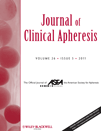Donor survey to assess facial flushing during automated red cell collections and medication use
Abstract
Background: We conducted a donor survey to assess the occurrence of facial flushing and other symptoms during automated 2-U red cell collections (2RBC) and plateletpheresis (PLT) procedures and evaluated the possible association of the reactions with angiotensin-converting enzyme (ACE) inhibitors or with the collection technology. Methods: An online survey was developed using Zoomerang to capture details of the donors' experience and medication use after 2RBC or PLT donations in regional blood centers of the American Red Cross. Results: Between 12/16/09 and 4/19/10, 1,299 donors in five American Red Cross blood center regions completed an online survey (739 2RBC, 4.2% total registrations; 560 PLT, 2.3% total registrations). Facial flushing was reported by 29 donors, and was more likely associated with 2RBC than PLT procedures (3.0% vs. 1.3%, P = 0.03). Facial flushing with 2RBC donation was reported by eight of 72 (11%) donors on ACE inhibitors; and 14 of 667 (2%) donors who were not taking ACE inhibitors (P = 0.001). The incidence of facial flushing reactions with PLT donation was less than 2% whether donors reported ACEI inhibitor use or not. More than 95% of the donors reported their intent to donate again, regardless of symptoms. Conclusion: Facial flushing was more often reported by 2RBC donors taking ACE inhibitors than other donors [11% vs. 2%; P = 0.001]; and was uncommon among PLT donors, irrespective of ACE inhibitor use (<2%). All blood donors should be informed of the potential for common, minor side effects of the collection procedure and the possible but rare occurrence of more medically serious complications. J. Clin. Apheresis, 2011. © 2011 Wiley-Liss, Inc.




